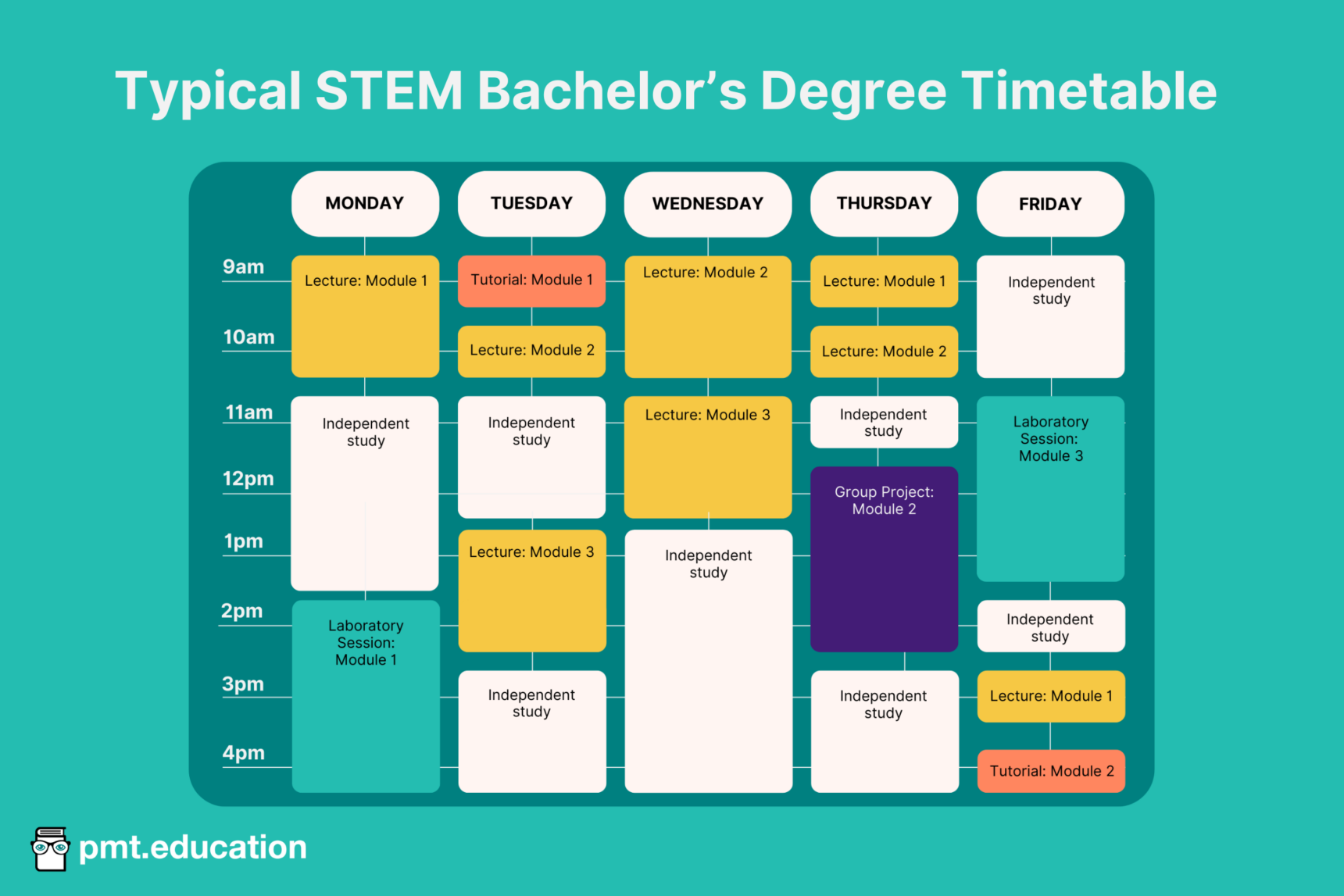Contents:
Qualification Level: Undergraduate (Level 6)
Entry Requirements: Minimum academic qualifications, sometimes entrance exams
Cost: Tuition fees, typically £9,250 per year for UK students
Assessment Methods: Exams, coursework, labs, dissertation
Skills Developed: Subject-specific knowledge, critical thinking
Career opportunities: Entry-level positions in various industries, further study
What is a STEM bachelor’s degree?
A STEM bachelor’s degree is an undergraduate academic programme in the UK, offered by universities. Undergraduate degrees are typically undertaken by students over the age of 18 and take three years to complete in England.
STEM bachelor’s degrees place a strong emphasis on independent learning, providing students with both the theoretical knowledge and practical skills necessary for a career in their chosen field. This article outlines the various bachelor’s degrees available and guides you through a STEM bachelor’s degree from application to completion.
Why should you do a bachelor’s degree?
Your primary reason for pursuing a STEM bachelor’s degree should be a genuine interest in learning more about a specific area of STEM. This passion will be essential for both enjoying your studies and succeeding amidst the degree’s intensity. While there are many other motivating factors for embarking on a bachelor’s degree – such as opening up numerous career opportunities, enhancing your job prospects, providing a pathway to academia, and potentially increasing your earning potential – your enthusiasm for the subject is key.
If you are unsure what career you wish to pursue, a bachelor’s degree allows you to explore more options within STEM while still progressing with your education. If you have specific career aspirations and are torn between a bachelor’s degree or a vocational qualification, consider taking a placement year as part of your bachelor’s degree.

Before your bachelor’s degree
What bachelor’s degrees are available in STEM?
Typical STEM degrees can be categorised into:
- Bachelor of Science (BSc)
- Bachelor of Engineering (BEng)
- Bachelor of Technology (BTech)
- Bachelor of Pharmacy (BPharm)
- Bachelor of Medicine (MBBS)
- Bachelor of Veterinary Medicine (BVetMed)
- Bachelor of Dentistry (BDS)
Within each category, there are many different subject areas and specialisms available, leading you down a vast array of exciting career-paths; a few of these are listed in the table below.
Medical communications
Laboratory technician
Mechanical engineer
Quality/reliability engineer
Software developer
Network architect
Mathematics teacher
Statistician
Patent lawyer
Pharmaceutical regulations
Most universities worldwide offer STEM bachelor’s degrees in the major STEM subject areas, but they also adapt each programme depending on the research interests of their lecturers. For example, while many universities offer Engineering degrees, the University of Bristol is among the few that offer a degree in Engineering Mathematics due to their lecturer’s specialism in the area.
Where can you find STEM bachelor’s degrees?
There are two main methods to find a STEM bachelor’s degree: exploring university websites to find courses available at a particular institution, or using comparison sites to discover which institutions offer a particular course. The method you choose should depend on which factor matters more to you – the university you attend or the specific course you want to study. A popular comparison site to use is The Complete University Guide.
Our article on applying to study STEM at university provides more information on how to effectively narrow down your choices.
STEM bachelor’s degrees offer more flexibility than you might expect
- Optional modules: As well as your mandatory modules, STEM bachelor’s degrees have optional modules which students can select from once at university. This lets you tailor the generic degree to suit your personal interests. The course programme should show your options, as is the case in this example of biochemistry module options at the University of Bristol.
- Joint honours: If you are interested in more than one STEM subject, many subjects are available as joint honours degrees (also known as combined honours). These are variations of bachelor’s degrees in which several subject areas are studied evenly. For example, a Psychology and Biology BSc is offered at Newcastle University. You can read more about joint honours here.
- Year abroad: Many STEM bachelor’s degrees offer the option to include a year abroad, allowing students to study at a foreign university, gain exposure to new areas of expertise, and immerse themselves in a different culture. You can search for opportunities on course comparison sites.
- Year in industry: Most STEM bachelor’s can also be taken with a year in industry, giving students with specific career aspirations the chance to demonstrate the applicability of their learning in the workplace. Our article on industrial placement years can provide more detail.
- Alternative modes of study: The standard, full-time, in-person, bachelor’s structure does not suit everyone. There are many bachelor’s degrees offering the option to study part-time, alongside work or care responsibilities, or online, with no or few elements in-person.
How do you apply for a STEM bachelor’s degree?
Applications for bachelor’s degrees are usually submitted in the final year of secondary school but a gap year (or several!) can be taken first. Once you have identified the STEM bachelor’s degrees that interest you, the application process involves:
- Meeting requirements: Ensure you meet the academic prerequisites, such as specific grades in IB, A Levels, BTECs, or equivalent qualifications.
- Submitting applications: Apply using the university’s application portal or the UCAS website.
- Supporting documents: Provide necessary documents such as qualification transcripts, personal statements, and letters of recommendation.
- Entrance exams: Some programmes use admissions tests to set students aside from one another, such as the UCAT for medical degrees and the LNAT for law.
- Interviews: Many universities will interview students before offering them a place on the programme they have applied for. These range from multiple mini-interviews (for medical degrees) to one-to-one discussions about your motivators.
How can PMT Education support you with your bachelor’s degree application?
At PMT Education, we offer a range of resources to help you navigate the application process with confidence. Whether you’re writing a personal statement, preparing for entrance exams, or seeking interview advice, we have the tools to support you. Here’s how we can assist:
- Detailed guidance on succeeding in the application process in our applying to study STEM at university article.
- An intensive Oxford PAT course designed for Oxford physics, engineering and materials science applicants.
- A tuition platform that connects you with private university admissions tutors for support with specific entrance exams, interviews, personal statements and finding scholarships or funding.
- A student blog with articles on key topics, including common university interview questions, personal statement tips, and guides to specific admissions tests.
What is a foundation year?
A STEM Foundation year adds an introductory year to a STEM bachelor’s degree, resulting in a four-year programme. It allows students to gain the skills and knowledge needed to take on a STEM degree – even if they have not met the regular entry requirements.
This is a popular option if you did not: attain the required entry grades, study the required entry subjects, or study a UK-recognised exam board. Many students select a foundation year even if they meet the entry requirements to make the transition to university smoother, gain a better understanding of the subject area they are interested in, or improve their confidence in English if it is not their first language. Most student find this year extremely beneficial; you can read about how a current STEM bachelor’s student found their foundation year on their online blog.
You can find courses with a foundation year by following the advice in our applying to study STEM at university article and searching for ‘foundation year’ specifically, on sites like UCAS and WhatUni.
How much does a bachelor’s degree cost?
The cost of a bachelor’s degree varies widely depending on the country, institution, and programme. In the UK, key expenses include:
- Tuition fees: Bachelor’s degree tuition fees in England cost up to £9250 per year, with the upper limit being the standard. Fees are often higher for international students.
- Application costs: Applying to university through UCAS comes with an application fee. This may be waived for applicants from lower-income households.
- Additional costs: Books, equipment, laptops, printing, lab fees, and transport to placements.
- Exam costs: Most bachelor’s degrees do not charge for examinations but it is worth checking whether national examinations must be sat and what their cost is, particularly for vocational degrees.
- Maintenance fees: Most students move away from home to study. The cost of living should be included when considering the overall cost. This includes rent, bills, food, travel, and leisure.

Funding options
The cost of a STEM bachelor’s degree can seem daunting, and it is extremely important to ensure you can afford it before accepting university offers. However, there is a wealth of financial support available to help students fund their degrees. Funding options include scholarships, bursaries, grants, and student loans. Student loans cover tuition fees and some maintenance fees. Your undergraduate tuition loan is up to £9250 per year, paid back as 9% of earnings over £25,000. Our STEM scholarships, grants and bursaries article explains far more about different funding options and how to apply for them.
Return on investment
STEM bachelor’s degrees can be considered an investment. Although they come with a high price tag, the return on this investment is well-known. Graduates with a STEM bachelor’s degree typically have higher earning potential with higher starting salaries compared to non-STEM fields. The repayment plans for tuition fee loans support the idea of a return on investment for bachelor’s degrees. Repayment plans only begin once a salary of £25,000 is earned, meaning you won’t need to start paying for your degree until you are more financially stable.
During your bachelor’s degree
At the start of your STEM bachelor’s degrees, you will be offered a variety of modules, allowing you to explore a wide range of subject areas within the STEM field you have chosen. As you progress through your degree, module options may become more restricted as you gradually begin to specialise, honing in on particular areas of interest. The exact structure of a specific course can be found by reviewing the course structure on the university’s website.
A day in the life of a STEM bachelor’s degree student
Bachelor’s degree students are generally expected to spend 8 hours a day studying. Unlike secondary school, you are not always required to be on campus for these 8 hours, because much of the day is dedicated to independent learning. Additionally, sessions may last longer than the one hour lessons you are used to in school, particularly laboratory sessions, which can last the whole day. Your daily schedule will be outlined on a student timetable and will include various session types that employ different teaching methods.

Learning methods common to most STEM bachelor’s degrees include:
- Lectures: Theoretical teaching delivered to your whole cohort and led by researchers who are specialists in the content you are covering.
- Tutorials: Focused teaching delivered to smaller groups of students, usually in a more interactive environment than lectures.
- Laboratory sessions: Research experiments and practical work, usually carried out in small groups or pairs, planned and carried out over several sessions. Laboratory preparation work usually precedes each session. Progress made in each session is tracked in a lab book and a laboratory report is written up at the end.
- Workshops: Hands-on, applied learning sessions covering knowledge demonstration, presentations, question and answer, and group discussion.
- Group projects: Collaborative learning and problem-solving projects which link to the modules studied. They aim to develop communication, presentation, and teamwork skills.
- Independent study: Reading, assignments, essays, dissertations, and exam preparation.
To give you a better idea for what a typical day might look like, an example timetable for a first-year Chemistry BSc student is shown below. There are also many student blogs that offer insights into a typical day in the life of a STEM bachelor’s student.

How is a STEM bachelor’s degree assessed?
Assessment methods vary between STEM bachelor’s degrees and universities. Generally, students are assessed throughout the year using coursework and at the end of the year through a formal examination. STEM coursework may include:
- Essays
- Group work
- Presentations
- Laboratory reports
- End of degree dissertation
The grades received in the other years of your bachelor’s are combined to give your final grade and classification:
- First-Class: 70%+
- Upper Second-Class: 60-70%
- Lower Second-Class: 50-60%
- Third-Class: 45-50%
- Pass: 40-45%
- Fail: Below 40%
Often, your first year of university requires only a pass and does not count towards your final grade. To see how your specific course is assessed, check the university’s programme details.
After a bachelor’s degree
After completing a bachelor’s degree, students typically pursue one of two main routes: entering the workforce or continuing in academia.
23% of bachelor’s graduates continue in academia. Continuing in academia allows you to gain more specialised knowledge and can lead to careers in research or lecturing. The next steps in academia, beyond a bachelor’s degree, are a Master’s degree or a Doctorate (a PhD). Alternatively, students may continue in academia with conversion degrees or graduate entry degrees, if they have changed their career aspirations during their bachelor’s degree and wish to study in another area.

Most students are sufficiently qualified to enter the workforce in their desired role with their bachelor’s degree. However, some roles may require you to specialise further through additional study or role-specific qualifications. Universities can provide ample advice and support through career guidance, career events, and networking opportunities, often available to students for several years after graduation. In this respect, STEM bachelor’s students have an advantage in terms of support over those who enter the workforce immediately after secondary education.
STEM bachelor’s degree graduate outcomes
Graduates with STEM bachelor’s degrees have a higher employment rate than non-graduates, with significantly higher employment in highly-skilled roles.

The sum of the employment and unemployment do not equal 100% because the values are rounded and the rates are based on average (mean) figures over four different calendar quarters from the Labour Force Survey.
The higher employment rates for bachelor’s graduates reflect the greater abundance of job opportunities available, as some roles require a bachelor’s degree for eligibility.
However, this does not necessarily mean that bachelor’s graduates have a better chance of securing a specific job compared to someone without a degree. Many employers value experience and skills over formal qualifications and will consider candidates who have gained relevant experience and training since secondary school equally to those with a bachelor’s degree. For example, you can start working as a trainee laboratory technician directly after secondary school and receive the necessary training to advance to the senior roles, typically reserved for degree holders.
Is a STEM bachelor’s degree worth it?
Whether a STEM bachelor’s degree is ‘worth it’, depends on your passions, strengths, and career goals. The higher earning potential, enhanced career opportunities, and benefits to personal development make a STEM bachelor’s degree valuable to all students, not just those pursuing STEM careers. However, a bachelor’s degree may not be the right choice for everyone. These are high-intensity programmes with a strong emphasis on independent learning. If you are interested in a particular vocation, prefer teaching methods with more support, or find this path financially challenging, our articles on alternative routes into STEM might be helpful.
FAQs
What does BSc stand for?
BSc stands for Bachelor of Science.
BA vs BSc degree?
Bachelor of Arts (BA) degrees and Bachelor of Science (BSc) degrees are two different bachelor’s degrees offered by universities. Both bachelor’s degrees are well respected, providing the skills and knowledge for a career or further study. They simply offer different academic focuses. BA degrees encompass arts, humanities, and communication subjects, whilst BSc degrees focus on science, mathematics, and technology.
General BSc vs BTech, BEng, or BPharm?
Many subjects can be studied as both a Bachelor of Science (BSc) degree or a more specialised professional bachelor’s, such as a BTech for Technology, BEng for Engineering, and BPharm for Pharmacy. So, how do you choose which degree type to do? Studying your chosen subject as a BSc degree provides a broader knowledge about the area and the opportunity to also study interdisciplinary modules across STEM. BSc degrees usually attract students with a greater range of career aspirations due to their breadth of study. On the other hand, the professional bachelor’s degrees set up students for work in the specific profession, with highly focused learning and application to practical work experience.
BSc Hons meaning: What is the difference between BSc vs BSc Hons?
When you complete your bachelor’s degree you will be awarded an “honours” or “ordinary” degree depending upon the number of credits you obtained. The Bachelor of Science Honours degree (BSc Hons) is the higher level of achievement, awarded if you obtain 360 credits across the course duration. An ordinary degree is equivalent to 300 credits. Credits are given for each module taken and passed. BSc Hons degrees come with a degree classification (First, Second, Lower-second, Third), whilst ordinary degrees are marked as pass or fail.
What level is a bachelor’s degree?
Qualifications are categorised into levels by the UK Government. A bachelor’s degree is a Level 6 qualification.
How long is an undergraduate degree?
An undergraduate STEM bachelor’s degree takes at least 3 years to complete in England. Those that take longer include specialised professional degrees (such as Medicine, Veterinary, and Dentistry) or adapted degrees (with an industrial placement year or year abroad). In Scotland, bachelor’s degrees are at least four years, as students enter further study one year earlier. The extra year almost acts as a foundation year, with a broad range of STEM topics covered. However, students can request to enter straight into the second year of study.

Comments